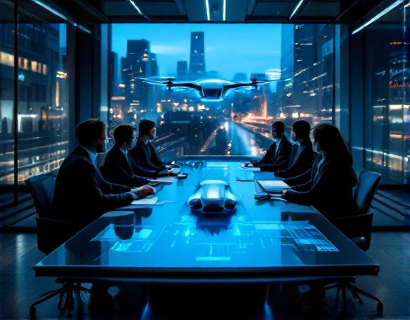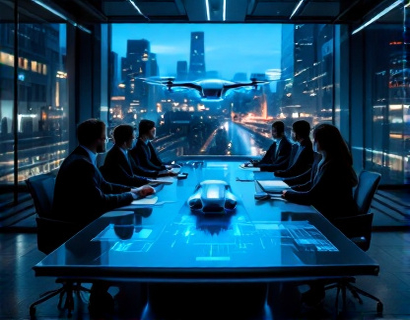AI-Powered Agent Revolutionizes Aeronautics: Streamlining Operations and Enhancing Decision-Making for Industry Professionals
The aeronautics industry, a cornerstone of global transportation and commerce, is undergoing a transformative shift with the integration of artificial intelligence (AI) technologies. This revolution is not just about automating routine tasks but about fundamentally changing how operations are managed and decisions are made. An AI-powered agent, designed with the specific challenges of the aeronautics sector in mind, is at the forefront of this change. This agent leverages advanced algorithms, machine learning, and data analytics to streamline operations and enhance decision-making processes, offering unprecedented efficiency and insight.
The aeronautics industry is characterized by complex, dynamic, and high-stakes operations. From flight planning and air traffic management to maintenance scheduling and supply chain logistics, the sector demands precision, reliability, and real-time adaptability. Traditional methods, while robust, often struggle to keep pace with the increasing volume of data and the speed at which conditions can change. This is where an AI-powered agent excels, providing a robust solution that can handle the intricacies of aeronautical operations with ease.
One of the primary ways an AI agent streamlines operations is through automated data processing and analysis. The agent can ingest vast amounts of data from various sources, including sensors, databases, and external systems, and process it in real-time. This capability allows for the immediate identification of patterns, anomalies, and trends that would be impossible for human operators to detect manually. For instance, the agent can monitor weather conditions, aircraft performance metrics, and air traffic data to optimize flight paths and reduce delays.
Flight planning is a critical aspect of aeronautical operations, requiring precise calculations and constant updates. An AI agent can significantly enhance this process by using predictive analytics to forecast the most efficient routes based on current and projected weather conditions, airspace restrictions, and aircraft capabilities. This not only saves time but also reduces fuel consumption, lowering operational costs and environmental impact. The agent can also dynamically adjust flight plans in response to real-time changes, ensuring that operations remain smooth and efficient.
Air traffic management is another area where the AI agent can make a substantial impact. Managing the flow of aircraft in busy airspace requires coordination and decision-making at a scale that human controllers cannot handle alone. The agent can assist air traffic controllers by providing real-time recommendations for route adjustments, altitude changes, and conflict resolutions. By analyzing vast datasets and simulating multiple scenarios, the agent can suggest the optimal actions to maintain safety and efficiency, reducing the risk of accidents and improving overall airspace utilization.
Maintenance scheduling and management are essential for ensuring the reliability and safety of aircraft. Traditional maintenance schedules are often based on fixed intervals or historical data, which may not account for the actual condition of the aircraft. An AI agent can perform predictive maintenance by analyzing sensor data from aircraft systems to predict potential failures before they occur. This proactive approach allows for timely maintenance, reducing downtime and extending the lifespan of aircraft components. The agent can also optimize maintenance schedules to minimize disruptions and resource utilization.
Supply chain logistics in the aeronautics industry involve a complex network of suppliers, manufacturers, and distributors. Ensuring that parts and materials are available when needed is crucial for maintaining operational continuity. An AI agent can enhance supply chain management by providing demand forecasting, inventory optimization, and supplier performance monitoring. By analyzing historical data and market trends, the agent can predict future demand and adjust inventory levels accordingly, reducing excess stock and stockouts. Additionally, the agent can identify potential supply chain disruptions and suggest alternative sourcing options to mitigate risks.
Decision-making in the aeronautics industry is often based on a combination of expert knowledge and empirical data. However, the sheer volume of data and the complexity of the systems involved can overwhelm human decision-makers. An AI agent can augment human capabilities by providing data-driven insights and recommendations. For example, in the context of fleet management, the agent can analyze performance data, maintenance records, and operational costs to suggest the most cost-effective fleet composition and usage strategies. This can lead to significant cost savings and improved operational performance.
The integration of AI in aeronautical operations also enhances situational awareness and crisis management. In scenarios such as natural disasters or unexpected events that disrupt normal operations, the agent can quickly assess the situation, identify critical issues, and propose immediate actions. This rapid response capability is invaluable for minimizing the impact of disruptions and ensuring the safety of personnel and assets. The agent can coordinate with multiple stakeholders, including airport authorities, emergency services, and airline operations, to implement a unified response strategy.
Moreover, the AI agent can contribute to regulatory compliance and safety standards. The aeronautics industry is heavily regulated, with strict requirements for data reporting, safety audits, and operational procedures. The agent can automate the collection and submission of required data, ensuring that all regulatory requirements are met consistently and accurately. This not only reduces the administrative burden on staff but also enhances the reliability of compliance processes.
The benefits of an AI-powered agent extend beyond operational efficiency and decision-making. It also plays a crucial role in driving innovation within the aeronautics industry. By analyzing large datasets and identifying emerging trends, the agent can highlight areas for research and development, guiding companies towards innovative solutions. For instance, the agent can identify opportunities for integrating new technologies, such as advanced materials, electric propulsion systems, or autonomous flight capabilities, into existing operations. This forward-looking approach helps aeronautics businesses stay competitive and adapt to the rapidly evolving technological landscape.
Implementing an AI agent in the aeronautics industry requires a strategic approach to ensure successful integration and maximum benefit. Initial steps include assessing the specific needs and challenges of the organization, selecting the appropriate AI technologies, and developing a comprehensive implementation plan. Collaboration with AI experts and industry specialists is essential to tailor the agent's capabilities to the unique requirements of the aeronautics sector. Continuous monitoring and refinement of the agent's performance are also critical to ensure that it adapts to changing conditions and continues to deliver value over time.
In conclusion, the integration of an AI-powered agent in the aeronautics industry represents a significant leap forward in operational efficiency, decision-making, and innovation. By automating routine tasks, providing real-time insights, and enhancing situational awareness, the agent empowers industry professionals to manage complex operations with greater ease and effectiveness. As the aeronautics industry continues to evolve, the role of AI will become increasingly vital, driving the sector towards a more sustainable, safe, and efficient future.










































